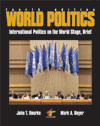"Once upon a time," began a fable told by the great British
diplomat and prime minister Winston Churchill, "all the animals
in the zoo decided that they would disarm." To accomplish that
laudable goal, the animals convened a diplomatic conference, where,
Churchill's tale went: "The Rhinoceros said when he opened the proceeding that the
use of teeth was barbarous and horrible and ought to be strictly
prohibited by general consent. Horns, which were mainly defensive
weapons, would, of course, have to be allowed. The Buffalo, the Stag,
the Porcupine, and even the little Hedgehog all said they would vote
with the Rhino, but the Lion and the Tiger took a different view.
They defended teeth and even claws, which they described as
honourable weapons of immemorial antiquity. The Panther, the Leopard,
the Puma, and the whole tribe of small cats all supported the Lion
and the Tiger. Then the Bear spoke. He proposed that both teeth and
horns should be banned and never used again for fighting by animals.
It would be quite enough if animals were allowed to give each other a
good hug when they quarreled. No one could object to that. It was so
fraternal, and that would be a great step toward peace. However, all
the other animals were very offended by the Bear, and the Turkey fell
into a perfect panic. The discussion got so hot and angry, and all
those animals began thinking so much about horns and teeth and
hugging when they argued about the peaceful intentions that had
brought them together, that they began to look at one another in a
very nasty way. Luckily the keepers were able to calm them down and
persuade them to go back quietly to their cages, and they began to
feel quite friendly with one another again." Sir Winston's allegory is instructive, as well as colorfully
entertaining. It touches on many aspects of diplomacy discussed in
this chapter. We will begin by looking at power, which remains
an essential element of diplomacy in a system based on
self-interested sovereignty. In our world, like the zoo, the actors
that possess the power to give rewards or inflict punishment are able
to influence other actors. Power has many forms. Physical strength is
one, and the rhino and the lion were both powerful in this way. Skill
is another aspect of power. The turkey had little tangible strength,
but perhaps it possessed guile and other intangible diplomatic skills
to persuade the other animals to adopt its views. Economic power is
also important in diplomacy. The zookeepers controlled the food
supply, and may have used food as a positive incentive (more food) or
negative sanction (less or no food) to persuade the animals to return
to their cages. Having established the power foundations of diplomacy, we will turn
to the general nature of diplomacy. This involves the overall
system, the setting in which modern diplomacy occurs. The zoo was the
system in which the animals negotiated. Like the current
international system, the zoo system was based on self-interest, with
each group of animals selecting goals that were advantageous to
itself with little thought about how they affected others. The zoo
system also apparently allowed some potential for fighting and thus
based success in part on the Darwinian law of the jungle. Yet it is
the case that the animals were also partly constrained by the
zookeepers with, perhaps, some protection afforded by cages. The third part of this chapter will examine modern diplomacy by
looking at how it has evolved and at some of its characteristics.
Multilateral diplomacy, for example, has become a much more prominent
part of diplomacy than it once was. In Churchill's story, the animals
conducted multisided negotiations instead of bilateral diplomacy
between, say, just the rhino and the tiger. Those two animals might
have made a bilateral agreement that both horns and fangs were
acceptable; once hedgehogs, turkeys, and others became involved, the
diplomatic dynamic changed greatly. In such a circumstance,
diplomatic coalition building is one aspect of support gathering. It
may well have been that, before the conference, the rhino had met
with the buffalo, stag, porcupine, and hedgehog to convince them that
they should support the rhino's position that horns were defensive
weapons, while teeth and claws were offensive weapons. Finally, the fourth part of the chapter will turn to options in the
conduct of diplomacy. Direct negotiation is one method, and the
animals were engaged in that. Signaling is another method. This
occurred when the animals "began to look at each other in a very
nasty way." Public diplomacy to win the support of public opinion
is another diplomatic method, and it is possible to see in
Churchill's story how a clever diplomatic proposal can create an
advantage. One can imagine the bear's proposal emblazoned in the
Zoo News headline the next day: "Bear Proposes Eliminating
All Weapons. Suggests Hugging as Alternative to Fighting." World
opinion might have rallied to the bear; this would have put pressure
on the other negotiators to accede to a seemingly benign proposal to
usher in a new world order based on peace, love, and hugging. Before proceeding, we should take a moment to put this chapter in
context. It is the first of two chapters that look at the traditional
and the alternative bases for establishing what policies will prevail
in the world. The traditional approach involves countries' practicing
national diplomacy by applying power in the pursuit of their
self-interest. This approach does not mean that might makes right,
but it surely means that might usually makes success. The alternative
approach, discussed in Chapter 9, is to apply the standards of
international law and justice to the conduct of international
relations so that right, rather than who is mightiest, will more
often determine who prevails. |



 2002 McGraw-Hill Higher Education
2002 McGraw-Hill Higher Education